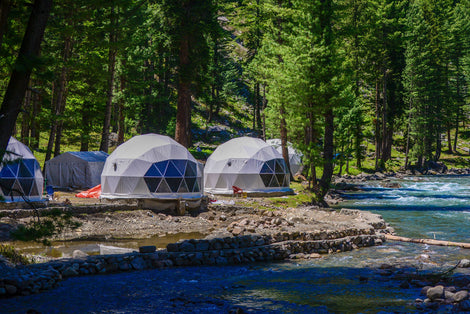Temperature Control Problems with Mini Split Systems
Mini split systems are one of the most efficient ways to heat and cool an off-grid space powered by solar. When set up properly, they offer quiet operation, zoned comfort, and dependable performance. But things can go sideways when the temperature doesn’t hold steady. Whether it’s a room that feels too warm even when the system is cooling, or a sudden blast of cold air during heat mode, inconsistent temperatures are frustrating and waste energy.
Achieving the right balance with a mini split system takes more than just flipping it on. If you’re using a model like the MRCOOL mini split system, it helps to know how it responds to changes in use, air flow, and temperature settings. Off-grid homes can present unique challenges, especially when the system is running entirely off solar power. Understanding where temperature issues begin and how to work around them can help keep things comfortable without draining your battery bank or overworking the system.
Common Temperature Control Issues With Mini Splits
Even with properly installed mini split systems, it’s not uncommon to run into hot and cold spots, especially in off-grid homes where insulation may vary from room to room. These systems work best when conditions remain relatively stable, and anything from frequent door openings to poor placement of the indoor unit can throw things off.
Here are some of the common issues people face with mini split temperature control:
- Rooms feeling warmer or cooler than the set temperature: This can happen when the thermostat sensor isn’t placed well or is picking up drafts or sunlight.
- Short cycling: If the system turns on and off too quickly, it won’t have time to fully regulate the room temperature.
- Overheating or overcooling: This might be caused by low refrigerant levels, blocked air filters, or a thermostat setting that’s just too far off base.
- Fan settings that never change: When fan speed stays constant, it can lead to uneven temperature distribution.
- Outdoor unit issues: If the condenser is blocked or dirty, the mini split will struggle to produce the correct temperature indoors.
In off-grid setups, there’s also the issue of power management. Temperature swings may line up with battery drain times, and in some cases, the system might underperform when solar production drops. For example, running the MRCOOL mini split during a cloudy stretch without battery reserves can cause it to shut off before it hits the target temperature.
By pinpointing which of these issues are happening, you’ll have a better shot at solving inconsistent temperature problems without guessing. Even small changes can make a big difference in improving comfort and extending the life of the system.
Optimizing MRCOOL Mini Split Settings
Once you’ve spotted the problem, one of the quickest ways to improve performance is adjusting the settings on your MRCOOL mini split. Getting the most out of this system starts with keeping a close eye on how it responds day to day and tweaking the way it runs for your space’s needs.
Start with the thermostat. What may seem like a small difference of just a few numbers can have a big impact both on comfort and power usage. Make sure your settings line up reasonably with the outdoor temperature. For off-grid homes, keeping targets a bit more moderate helps prevent overuse, which can drain your system during night hours when solar isn't active.
Here’s a list of quick setting tips that can help stabilize temperatures:
- Set your thermostat between 72°F and 76°F for cooling or between 68°F and 70°F for heating. Avoid extreme settings.
- Use auto mode to let the system choose fan speed and compressor load. It reacts more smoothly to changes in room temperature.
- Select dry or dehumidify mode in late summer or early fall when humidity lingers but temperatures are mild.
- Set a timer so the unit doesn’t run too long when no one is around. This saves energy and avoids rapid short cycling.
- Adjust the fan direction. Use the swing function to help distribute air more evenly, avoiding hot or cold spots.
- Avoid setting the fan on high constantly. Let it adjust as needed to maintain temperature without blowing too much cool or hot air at once.
The MRCOOL mini split system comes with a wide range of programmable features, but those only work well if they're dialed in based on how your space reacts. Keep changes simple and stick with one adjustment at a time to see how your system behaves. That approach helps you understand what works in real time without overwhelming the unit or your battery system.
Maintenance Tips for Consistent Temperatures
Even with smart thermostat settings and the right operation modes, your MRCOOL mini split system needs regular maintenance to stay consistent. Like anything mechanical, when the inside gets dirty or the outside is blocked, performance takes a hit. Off-grid systems are especially sensitive to small problems since energy is limited and every part needs to be working at its best.
The most basic but often skipped step is filter cleaning. Dirty filters restrict air flow, which leads to uneven heating or cooling. Set a habit to remove and rinse the filters every few weeks, especially if you're in a dusty area or use a wood stove nearby. Let them fully dry before putting them back.
Here are a few other upkeep habits that help reduce temperature issues:
- Wipe down the indoor unit’s vents to keep air moving freely
- Check the outdoor condenser for leaves, twigs, or snow build-up
- Make sure nothing is blocking airflow to the indoor unit (tall furniture, stored items, curtains)
- Look for water leaks around the indoor unit, which may signal a drainage clog
- Contact a technician to inspect refrigerant levels and check components annually
The outdoor unit also needs space to breathe. If weeds and brush grow around it, the system can overheat or freeze up, leading to shutdowns. In off-grid homes, the system may not restart until the battery bank is recharged, which usually means several uncomfortable hours or more without heating or cooling.
Other handy checks include making sure the drain lines aren’t clogged and listening for strange sounds. A quiet hum is normal, but anything grinding or buzzing could point to a worn part, which should be fixed before it turns into a bigger issue.
Enhancing System Efficiency in Off-Grid Homes
Getting your MRCOOL mini split system to run more efficiently isn’t just about how you use the controls. It’s also about how your space supports that efficiency. Little improvements inside the house can go a long way toward creating an even, reliable temperature that takes less power to sustain.
Start with insulation. Even if your walls are properly insulated, doors, windows, and attic spaces often leak more air than people think. Adding weather stripping and checking seals can reduce drafts that confuse the thermostat and keep the system running longer than it should.
Airflow inside the room also matters. If cold air from the unit is blowing directly on one spot, the thermostat will think the whole room is cool and shut off early. Using a ceiling fan to mix the air or changing where the mini split head is directed can help with balance.
Adding some habits to your routine will also make a difference:
- Close shades during the day in the summer to block heat
- Open shades in the winter to let sunlight support heating efforts
- Use the programmable functions to match your daily activity patterns
- Avoid stacking large items near vents or return air paths
- Turn off other heat-producing appliances near the indoor unit
If your space stays more consistent, the MRCOOL unit doesn’t have to work as hard, and in an off-grid home, that translates to less strain on your solar and battery setup. For example, in a small cabin where the mini split would struggle mid-afternoon once cloud cover rolls in, adding a thermal curtain helped maintain the target temperature longer, saving energy.
Keeping Your Cool with Smart Temperature Control
Being off the grid means thinking ahead. Your MRCOOL mini split system can deliver reliable heating and cooling without draining your power, but it needs a bit of attention and a smart setup. When it’s running well, the comfort is better, and the batteries last longer.
By tuning your settings, maintaining your setup, and adjusting your daily routines, you’ll get more from the system and deal with fewer hot and cold surprises. It’s really about making the pieces work together, including your gear, your space, and your energy plan. Once that’s dialed in, you won’t have to think twice about your mini split keeping up.
If you're looking to improve comfort while cutting back on energy use, a properly configured MRCOOL mini split system can make a big difference in your off-grid setup. At Green Vista Living, we’re here to help you get the most from your solar investment with products and support that keep your space running right year-round.







